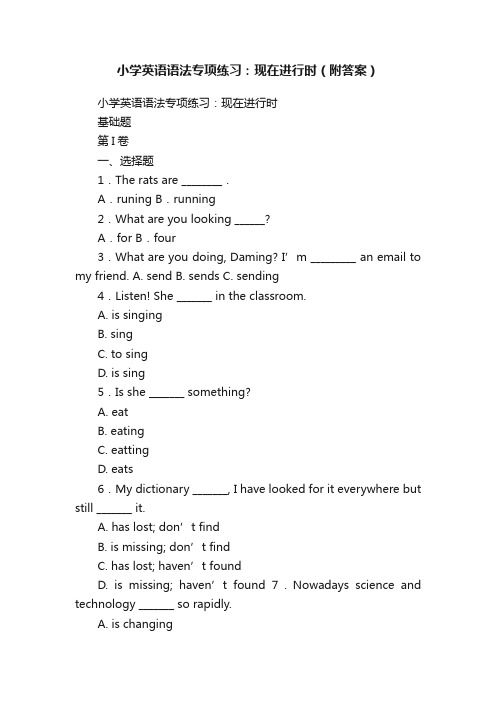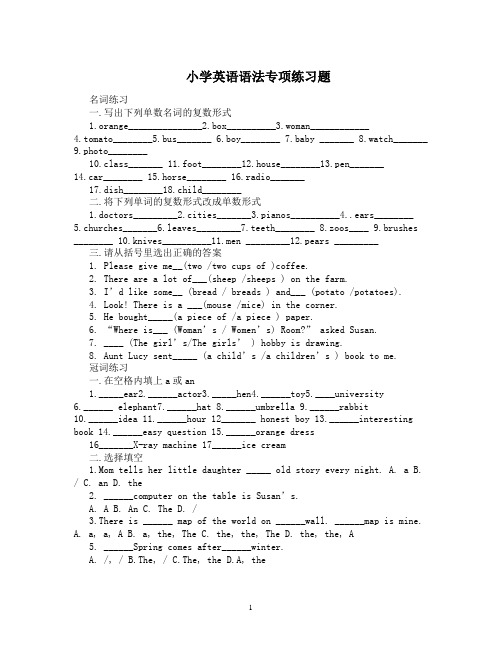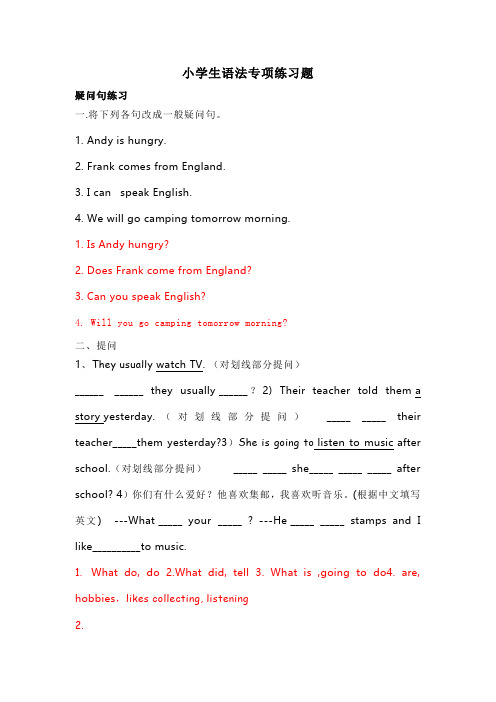小学英语语法专项练习题
小学英语语法专项练习:现在进行时(附答案)

小学英语语法专项练习:现在进行时(附答案)小学英语语法专项练习:现在进行时基础题第I卷一、选择题1.The rats are ________.A.runing B.running2.What are you looking ______?A.for B.four3.What are you doing, Daming? I’m _________ an email to my friend. A. send B. sends C. sending4.Listen! She _______ in the classroom.A. is singingB. singC. to singD. is sing5.Is she _______ something?A. eatB. eatingC. eattingD. eats6.My dictionary _______, I have looked for it everywhere but still _______ it.A. has lost; don’t findB. is missing; don’t findC. has lost; haven’t foundD. is missing; haven’t found 7.Nowadays science and technology _______ so rapidly.A. is changingB. has changedC. will have changedD. will change8.The bu ilding _______, I can’t stand the noise.A. was being builtB. is built9.I can’t catch up with the fashion, because the clothes style _______ all the time.A. has changedB. is changedC. is changingD. changed10.The children _______ football.A. is playingB. are playingC. play theD. play a11.Look! Lucy is _______ a new bike today.A. jumpingB. runningC. ridingD. talking12.( ) The children _______ football.A. is playingB. are playingC. play theD. play a13.( ) Listen!She _______ in the classroom.A. is singingB. singC. to singD. is sing14.( ) My dictionary _______,I have looked for it everywhere but still _______ it.A. has lost; don’t findB.is missing; don’t findC. has lost; haven’t foundD.is missing; haven’t found15.( ) Nowadays science and technology _______ so rapidly.A.is changingB. has changedC.will have changedD. will change二、填空题16.将下列句子改为现在进行时。
小学英语语法专项练习题含答案

小学英语语法专项练习题名词练习一.写出下列单数名词的复数形式1.orange_______________2.box__________3.woman____________4.tomato________5.bus_______6.boy________7.baby _______8.watch_______9.photo________10.class_______ 11.foot________12.house________13.pen_______14.car________ 15.horse________ 16.radio_______17.dish________18.child________二.将下列单词的复数形式改成单数形式1.doctors_________2.cities_______3.pianos__________4..ears________5.churches_______6.leaves_________7.teeth________8.zoos____9.brushes ________ 10.knives__________11.men _________12.pears _________三.请从括号里选出正确的答案1. Please give me__(two /two cups of )coffee.2. There are a lot of___(sheep /sheeps ) on the farm.3. I’d like some__ (bread / breads ) and___ (potato /potatoes).4. Look! There is a ___(mouse /mice) in the corner.5. He bought_____(a piece of /a piece ) paper.6. “Where is___ (Woman’s / Women’s) Room?” asked Susan.7. ____ (The girl’s/The girls’ ) hobby is drawing.8. Aunt Lucy sent_____ (a child’s /a children’s ) book to me.冠词练习一.在空格内填上a或an1._____ear2.______actor3._____hen4.______toy5.____university6.______ elephant7.______hat8.______umbrella9.______rabbit10.______idea 11.______hour 12_______ honest boy 13.______interesting book 14.______easy question 15.______orange dress16_______X-ray machine 17______ice cream二.选择填空1.Mom tells her little daughter _____ old story every night. A. a B. / C. an D. the2. ______computer on the table is Susan’s.A. AB. AnC. TheD. /3.There is ______ map of the world on ______wall. ______map is mine.A. a, a, AB. a, the, TheC. the, the, TheD. the, the, A5. ______Spring comes after______winter.A. /, /B.The, /C.The, theD.A, the6.I bought ______shoes yesterday. ______ shoes are very beautiful. A. a, The B. a pair of, The C. the, The D. a pair, The pair7.He was ______ soldier in the Second World War.A. aB. anC. theD. /8.She can play______ and ______.A. the tennis, the guitarB. tennis, guitarC. the tennis, guitarD. tennis, the guitar9.I can see______moon and ______clouds in the sky. A. the, a B. a, aC. the, /D. the, the11. ______Tian’anmen Square is in__Beijing. A. /, / B. A, / C. The, / D. /, the212.—Can you tell me ______nearest bookshop?—Go straight and turn right at_______third crossing, and you willsee it. A. the, a B. the, the C. a, the D. the, /三根据中文,写出下列固定搭配的英文。
小学英语语法练习题及答案

小学英语语法练习题及答案一、单项选择题1. — ______ does your father go to work?— He goes to work by car.A. HowB. WhenC. WhereD. Why2. My friend and I _______ to the park last Sunday.A. goB. wentC. goesD. is going3. _______ two pencils on the desk.A. There'sB. ThereC. They'reD. Here4. Helen ________ carrots and tomatoes for dinner.A. likeB. likesC. is likingD. liked5. _______ any milk in the fridge?A. There isB. Is thereC. There areD. Are there二、完形填空题John and Lisa are brother and sister. They are from the United States. They 1 a small garden. 2 garden is behind their house. In the garden, there 3 a big tree, some flowers, and a pond. Every 4 John and Lisa play in their garden. They 5 a lot of fun there.One day, they saw 6 small bird near the pond with a broken wing. The bird 7 fly away. John and Lisa 8 the bird and put it in a small box. They gave the bird some food and water. They wanted 9 bird to get better.Every day, John and Lisa took care of the bird. They talked 10 it and sang songs to it. After a few weeks, the bird's wing 11 better. It was 12 to fly again. John and Lisa opened the box and the bird flew away happily.John and Lisa were very happy 13 they helped a little bird. They loved animals and wanted to take care 14 them. They knew that everyone could 15 a small part to make the world a better place.1. A. has B. have C. had D. having2. A. Their B. They C. Them D. Theirs3. A. are B. is C. was D. were4. A. day B. night C. week D. morning5. A. is having B. has C. have D. had6. A. the B. a C. an D. and7. A. can't B. couldn't C. can D. could8. A. took care of B. took care C. take care of D. are taking care of9. A. a B. an C. the D. /10. A. to B. about C. with D. on11. A. gets B. got C. get D. getting12. A. able B. not able C. couldn't D. can't13. A. if B. because C. when D. while14. A. from B. for C. about D. of15. A. do B. did C. does D. doing三、阅读理解题ADear Sarah,How are you? I hope you are doing well. I am writing to tell you about my trip to Beijing. Beijing is the capital city of China. It is a very big and beautiful city.I visited the Great Wall. It was amazing! The Great Wall is very long and old. We took many photos there. I also went to the Summer Palace. It is a big park with a lake. We took a boat on the lake. It was so much fun!The food in Beijing was delicious. I tried Peking duck. It was very tasty.I also bought some souvenirs for you. I hope you like them.I miss you a lot. Don't forget to write back and tell me about your summer vacation.Love,Amy1. Where did Amy go on her trip?A. ShanghaiB. BeijingC. Hong KongD. Guangzhou2. What did Amy think of the Great Wall?A. BeautifulB. BoringC. SmallD. New3. What did Amy do at the Summer Palace?A. Took a boat on the lakeB. Climbed a mountainC. Visited a museumD. Took many photos4. What did Amy eat in Beijing?A. RiceB. NoodlesC. Peking duckD. SushiBMy name is Tom. I am 11 years old. I live in London, England. I have two brothers and one sister. My brothers are older than me, and my sister is younger. We all go to the same school.My favorite subject in school is math. I like solving math problems. My least favorite subject is history. I think it's boring.In my free time, I like playing soccer with my friends. I am on the school soccer team. We practice every Tuesday and Thursday after school. We have matches on Saturdays.I also enjoy reading books. My favorite book is Harry Potter. I have read all the books in the series. I like the adventures of Harry and his friends.1. How old is Tom?A. 10B. 11C. 12D. 132. What is Tom's favorite subject in school?A. MathB. EnglishC. HistoryD. Science3. How often does Tom practice soccer with his team?A. Every dayB. Every Monday and WednesdayC. Every Tuesday and ThursdayD. Every Saturday4. What is Tom's favorite book?A. Alice in WonderlandB. Charlotte's WebC. Harry PotterD. Matilda答案:一、单项选择题:1. A 2. B 3. C 4. B 5. B二、完形填空题:1. B 2. A 3. B 4. A 5. C 6. C 7. B 8. A 9. A 10.B 11. B 12. A 13.C 14.D 15. A三、阅读理解题:A: 1. B 2. A 3. A 4. C B: 1. B 2. A 3. C 4. C。
(完整版)小学英语语法专项练习题

小学英语语法练习题名词练习2.写出下列单数名词的复数形式1.orange_____2.box______3.woman_______4.tomato________5.bus_______ 7.boy________ 8.baby _______ 9.watch_______ 10.photo________ 11.class_______ 12.foot________ 13.house________14.pen_______ 15.car________ 16.horse________ 17.radio_______ 18.dish________19.child________2.将下列单词的复数形式改成单数形式1.doctors_________2.cities_______3.pianos_________4..ears________5.churches________6.leaves_________7.teeth________8.zoos____9.brushes________ 10.wives__________ 11.men _________12.pears _________3.请从括号里选出正确的答案1. Please give me (two /two cups of )coffee.2. There are a lot of (sheep /sheeps ) on the farm.3. I’d like some (bread / breads ) and (potato /potatoes).4. Look! There is a (mouse /mice) in the corner.5. He bought (a piece of /a piece ) paper.6. “Where is (Woman’s / Women’s) Room?” asked Susan.7. (The girl’s/The girls’ )hobby is drawing.8. Aunt Lucy sent (a child’s /a children’s ) book to me.冠词练习1.在空格内填上a或an1._____ear2.______actor3._____hen4.______toy5.____university6.______elephant7.______ hat8.______umbrella9.______rabbit 10.______idea11.______hour 12_______ honest boy 13.______interesting book14.______easy question15.______orange dress 17_______X-ray machine 18.______ice cream2.选择填空1.Mom tells her little daughter old story every night. A. a B. / C. an D. the2. computer on the table is Susan’s. A. A B. An C. The D. /3.There is map of the world on wall. map is mine.A. a, a, AB. a, the, TheC. the, the, TheD. the, the, A5. Spring comes after winter. A. /, / B.The, / C.The, the D.A, the6.I bought shoes yesterday. shoes are very beautiful.A. a, TheB. a pair of, TheC. the, TheD. a pair, The pair7.He was soldier in the Second World War. A. a B. an C. the D. /8.She can play and .A. the tennis, the guitarB. tennis, guitarC. the tennis, guitarD. tennis, the guitar9.I can see moon and clouds in the sky. A. the, a B. a, a C. the, / D. the, the11. Tian’anmen Square is in Beijing. A. /, / B. A, / C. The, / D. /, the12.—Can you tell me nearest bookshop?—Go straight and turn right at_______third crossing, and you will see it.A. the, aB. the, theC. a, theD. the, /5.根据中文,写出下列固定搭配的英文。
小学英语语法专项练习题

小学英语语法练习题名词练习2.写出下列单数名词的复数形式1.orange_____2.box______3.woman_______4.tomato________5.bus_______ 7.boy________ 8.baby_______ 9.watch_______ 10.photo________ 11.class_______ 12.foot________13.house________14.pen_______ 15.car________ 16.horse________ 17.radio_______ 18.dish________19.child________2.将下列单词的复数形式改成单数形式1.doctors_________2.cities_______3.pianos_________4..ears________5.churches________6.leav es_________7.teeth________8.zoos____9.brushes________ 10.wives__________11.men _________12.pears _________3.请从括号里选出正确的答案1. Please give me (two /two cups of )coffee.2. There are a lot of (sheep /sheeps ) on the farm.3. I’d like some (bread / breads ) and (potato /potatoes).4. Look! There is a (mouse /mice) in the corner.5. He bought (a piece of /a piece ) paper.6. “Where is (Woman’s / Women’s) Room?” asked Susan.7. (The girl’s/The girls’ )hobby is drawing.8. Aunt Lucy sent (a child’s /a children’s ) book to me.冠词练习1.在空格内填上a或an1._____ear2.______actor3._____hen4.______toy5.____university6.______elephant7.______hat8.______umbrella 9.______rabbit 10.______idea11.______hour 12_______ honest boy 13.______interesting book14.______easy question15.______orange dress 17_______X-ray machine 18.______ice cream 2.选择填空1.Mom tells her little daughter old story every night. A. a B. / C. an D. the2. computer on the table is Susan’s. A.A B. An C. The D. /3.There is map of the world on wall. map ismine.A. a, a, AB. a, the, TheC. the, the, TheD. the, the, A5. Spring comes after winter. A. /, / B.The,/ C.The, the D.A, the6.I bought shoes yesterday. shoes are very beautiful.A. a, TheB. a pair of, TheC. the, TheD. a pair, The pair7.He was soldier in the Second World War. A. a B. an C.the D. /8.She can play and .A. the tennis, the guitarB. tennis, guitarC. the tennis, guitarD. tennis, theguitar9.I can see moon and clouds in the sky. A. the, a B. a,a C. the, / D. the, the11. Tian’anmen Square is in Beijing. A. /, / B. A, / C.The, / D. /, the12.—Can you tell me nearest bookshop?—Go straight and turn right at_______third crossing, and you will see it.A. the, aB. the, theC. a, theD. the, /5.根据中文,写出下列固定搭配的英文。
小学生英语语法练习题5篇

【导语】英语语法是针对英语语⾔进⾏研究后,系统地总结归纳出来的⼀系列语⾔规则。
英语语法的精髓在于掌握语⾔的使⽤。
以下是⽆忧考整理的《⼩学⽣英语语法练习题5篇》相关资料,希望帮助到您。
1.⼩学⽣英语语法练习题 1.The boy __________________ ( draw)a picture now. 2. Listen .Some girls _______________ ( sing)in the classroom . 3. My mother _________________ ( cook )some nice food now. 4. What _____ you ______ ( do ) now? 5. Look . They _______________( have) an English lesson . 6.They ____________(not ,water) the flowers now. 7.Look! the girls ________________(dance )in the classroom . 8.What is our granddaughter doing? She _________(listen ) to music. 9. It's 5 o'clock now. We _____________(have)supper now 10.______Helen____________(wash )clothes? Yes ,she is .2.⼩学⽣英语语法练习题 ⽤动词的适当形式填空 1. It ______ (be) Ben’s birthday last Friday. 2. We all ______ (have) a good time last night. 3. He ________ (jump) high on last Sports Day. 4. Helen ________ (milk) a cow on Friday. 5. She likes ______ newspapers, but she ______ a book yesterday. (read) 6. He _______ football now, but they _______ basketball just now. (play) 7. Jim’s mother _________ (plant) trees just now. 8. _______ they ________ (sweep) the floor on Sunday? No, they _____. 9. I _______ (watch) a cartoon on Monday. 10. We ___________ (go) to school on Sunday.3.⼩学⽣英语语法练习题 在空格内填上a或an1. _____ear2.______actor3. _____hen4. ______toy5. ______university6. ______elephant7. ______hat8.______umbrella9.______rabbit 10.______idea 11.______hour 12_______ honest boy 13.______interesting book 14.______easy question 15.______orange dress 16_______apple pie 17_______X-ray machine 18.______ice cream2.⼩学⽣英语语法练习题 写出下列单数名词的复数形式1.knife _______2.orange_________3.box __________4. cap _______5. woman ________6. tomato ________7. bus _______8. hero _________ 9. boy ________ 10. baby _______ 11.roof________ 12.watch_______ 13. photo________ 14.class_______ 15. foot________ 16.house________ 17.pen_______ 18.car________ 19.horse________ 20.shelf_______ 21.radio________ 22.fox.________ 23.dish________ 24.half_________ 25.deer _________ 26.child________ 27.fish _____3.⼩学⽣英语语法练习题 名词复数规则 1.⼀般情况下,直接加-s,如:book-books,bag-bags, cat-cats, bed-beds 2.以s. x. sh. ch结尾,加-es,如:bus-buses, box-boxes, brush-brushes, watch-watches 3.以“辅⾳字母+y”结尾,变y为i, 再加-es,如:family-families, strawberry-strawberries 4.以“f或fe”结尾,变f或fe为v, 再加-es,如:knife-knives 5.不规则名词复数: man-men, woman-women, policeman-policemen, policewoman-policewomen,mouse-mice, child-children, foot-feet, tooth-teeth, fish-fish, people-people, Chinese-Chinese, Japanese-Japanese 练习:写出下列各词的复数 I _________him _________this ___________her ______ watch _______child _______photo ________diary ______ day________ foot________ book_______ dress ________ tooth_______ sheep ______box_______ strawberry _____ thief _______yo-yo ______ peach______ sandwich ______ man______ woman_______ paper_______ juice___________ water________ milk________ rice__________ tea__________。
小学英语语法专项练习大全(附答案)

小学英语语法专项练习大全(附答案)一、疑问句练将下列各句改成一般疑问句。
1.Is Andy hungry?2.Does Frank come from England?3.Can you speak English?4.Will you go camping tomorrow morning?二、提问1.What do they usually do?2.What did their teacher tell them yesterday?3.What is she going to do after school?4.What are your hobbies。
XXX.三、冠词练在空格内填上a或an1.an ear2.an actor3.XXX4.a XXX5.a university6.an XXX7.XXX8.an XXX9.XXX10.an idea11.an hour12.an honest boy13.an interesting book14.an easy n15.an orange dressXXX13.______sun is shining and ______birds are singing. A。
The。
theB。
/。
/C。
The。
/D。
/。
the14.______honesty is the best policy.A。
XXX15.______airplane is a fast means of XXX.A。
XXX答案:1.A2.D3.A。
the。
The4.C5.B6.A pair of。
The7.A8.Tennis。
guitar9.The。
/11.The。
/12.The13.The。
/14.A15.An改写后的文章:X-XXX by people all over the world.XXX my little sister an old story every night before bed。
小学英语语法专项练习大全(附答案)

小学生语法专项练习题疑问句练习一.将下列各句改成一般疑问句。
1. Andy is hungry.2. Frank comes from England.3. I can speak English.4. We will go camping tomorrow morning.1. Is Andy hungry?2. Does Frank come from England?3. Can you speak English?4. Will you go camping tomorrow morning?二、提问1、They usually watch TV. (对划线部分提问)______ ______ they usually ______?2) Their teacher told them a story yesterday.(对划线部分提问) _____ _____ their teacher_____them yesterday?3)She is going to listen to music after school.(对划线部分提问) _____ _____ she_____ _____ _____ after school? 4)你们有什么爱好?他喜欢集邮,我喜欢听音乐。
(根据中文填写英文)---What _____ your _____ ? ---He _____ _____ stamps and I like__________to music.1. What do, do2.What did, tell3. What is ,going to do4. are, hobbies,likes collecting, listening2.冠词练习一.在空格内填上a或an1._____ear2.______actor3._____hen4.______toy5.____university6.______ elephant7.______hat8.______umbrella9.______rabbit 10.______idea 11.______hour 12_______ honest boy 13.______interesting book 14.______easy question 15.______orange dress16_______X-ray machine 17______ice cream答案1. an2. an3. a4. a5. a6. an 7 a. 8. an 9. a 10. an 11. an 12.an 13 an14. an 15.an 16.an 17 an二.选择填空1.Mom tells her little daughter _____ old story every night.A. aB. /C. anD. the2. ______computer on the table is Susan’s.A. AB. AnC. TheD. /3.There is ______ map of the world on ______wall. ______map is mine.A. a, a, AB. a, the, TheC. the, the, TheD. the, the, A5. ______Spring comes after______winter.A. /, /B.The, /C.The, theD.A, the6.I bought ______shoes yesterday. ______ shoes are very beautiful.A. a, TheB. a pair of, TheC. the, TheD. a pair, The pair7.He was ______ soldier in the Second World War.A. aB. anC. theD. /8.She can play______ and ______.A. the tennis, the guitarB. tennis, guitarC. the tennis, guitarD. tennis, the guitar9.I can see______moon and ______clouds in the sky.A. the, aB. a, aC. the, /D. the, the11. ______Tian’anmen Square is in__Beijing. A. /, / B. A, / C. The, / D. /, the12.—Can you tell me ______nearest bookshop?—Go straight and turn right at_______third crossing, and you will see it.A. the, aB. the, theC. a, theD. the, /红色为答案。
- 1、下载文档前请自行甄别文档内容的完整性,平台不提供额外的编辑、内容补充、找答案等附加服务。
- 2、"仅部分预览"的文档,不可在线预览部分如存在完整性等问题,可反馈申请退款(可完整预览的文档不适用该条件!)。
- 3、如文档侵犯您的权益,请联系客服反馈,我们会尽快为您处理(人工客服工作时间:9:00-18:30)。
名词练习题一、写出下列名词的复数形式puter ____________2.apple ____________3.city ______________4.house _____________5.sheep _____________6.watch ______________7.tomato _____________8.child _____________9.tooth ________10.foot ______________ 11.wife _____________ 12.potato ____________ 13.play _____________ 14.day ____________ 15.glass ______________ 16.radio ______________ 17.zoo ______________ 18. life ______________ 19. story _____________ 20.leaf _____________ 21. baby _____________ 22.dress _____________ 23.butterfly _____________ 24. deer _____________ 25.class _____________ 26.brush _____________ 27.key _____________28. English ____________ 29.mouse ____________ 30. man _____________二、汉译英1.Tom的足球_________________ 2.老师们的自行车_________________ 3.学生们的课桌_________________ 4.哥哥的文具盒_________________ 5.姑姑的卡片_________________ 6.猴子们的香蕉_________________ 7.蚂蚁们的早餐_________________ 8.妈妈的包_________________9.姐姐的连衣裙_________________ 10女孩们的苹果_________________三、把下列句子翻译成英文1.这些是Peter 的篮球吗?________________________________________ 2.这个是老师的钢笔吗?___________________________________________ 3.有一些书在Sam的课桌上。
________________________________________ 4.有一些孩子们在教室里。
___________________________________________四、改错(圈出错处,在横线上改正过来)1.There are some butterflys on the table. ________________________2.This is Alice dress. ______________________3.I like tomato very much. __________________五、将下列句子变成复数形式。
1.This dog is brown.2. There is a book and a pen on the table.3.That woman is a teacher.能力测试卷(名词)一、将下列名词变成复数形式。
1.plane tree lessonmonth apple shirt2. box bus brushwatch class fox3.knife life leafWife thief4.day boy monkeybaby country story5.photo radio pianotomato hero6. child tooth manSheep English Chinese二、判断正误,并改正错句,正确的打“√”1.The house is my brother. ________________________2. He has visited many country. ______________________3. They are Englishs. ______________________________4. This is Tom red bike. ____________________________三、选择填空1.There are two ______ in the room.A. ChinesesB. Englishman2.The old man will have ___________ out.A. two toothsB. two teeth3. ____________ are sold in this bookstore.A. Children’s booksB. Children books4. Some friends of _________ will come here.A. John’sB. John5. Can you give me ______________?A. some papersB. a piece of paper6.There are ______________ on the floor.A. some boxB. some boxes四、将下列句子变成复数形式。
1.This sheep is white.2. There is a desk and a chair in the room.3.That man is a doctor.代词练习题一、根据题意,用所给词的适当形式填空。
1.Mary is a friend of ______________. ( I )2.This is ________ ( she ) ruler. ________ ( I ) is in the bag.3.Her brother is too young to look after _________ ( he )4.This is _________ ( I ) book. This book is _________ ( I ).5.These pens are _________ ( we ).三、改写下列句子Eg, This is my book. ------ The book is mine.1.That is her ruler. _________________________________2.These are their footballs. __________________________________3.This is my backpack . ____________________________________4.Those are your boxes. ____________________________________四、把下列句子改写成复数。
1. This is a butterfly. ____________________________________________2. That is a bus. ________________________________________________3. It is a mouse. ________________________________________________五、改错。
1.This is mine lamp. ___________________________________________2.These are ours books.____________________________________________3. That are their teacher. ___________________________________________4.The house is my brother. ________________________5. He has visited many country. ______________________6. They are Chineses. ______________________________7. This is Tom red bike. ____________________________能力测试卷(代词)一、帮下面的好朋友团圆(连线)I 她its 我们her 他(她,它)们we 我they 你的their 他(她,它)们your 她的she 它的二、填空1.She’s a teacher . This is _________ bag.2. He’s a driver. This is ___________ taxi.3. I am a boy . __________ name is Peter.4. --What’s __________ name?-- My name is Tony.5. It’s my puppy. ______ name is Mimi.三、选择( ) 1.Your book is not so old as _________.A. himB. heC. hisD. she( ) 2. _____ book is it ? It’s ________.A. Whose…herB. Whose… hersC. Who…hersD. Whom… her ( ) 3. He is a friend of ________.A. ourB. usC. myD. mine四、改错1. I, you and he are all teachers. ______________________________________________________2. This is mine teddy bear. ______________________________________________________3. These are ours bags. ______________________________________________________4. These is their teachers. _____________________________________________________冠词和数词专项练习一、在空白处填上适当的冠词,不需要的填“/”。
